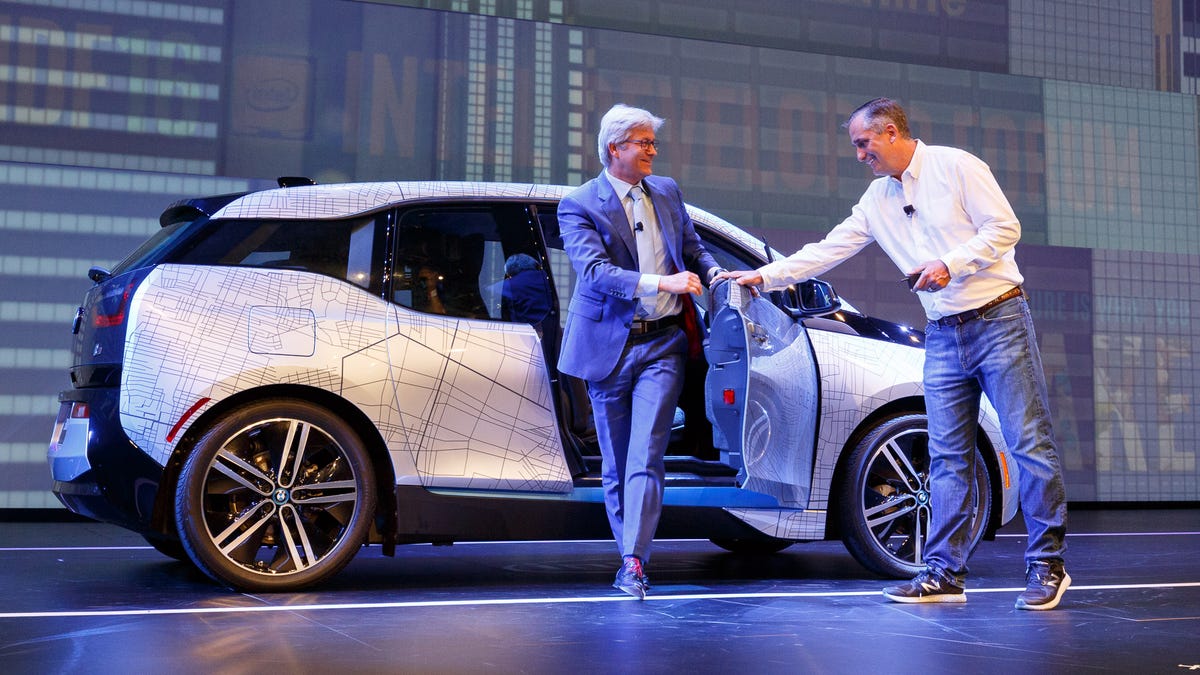Intel: We'll be your net-connected, self-driving car's brains
With processors and communication chips under its new Go brand, Intel hopes to revolutionize the auto industry -- and profit from the change.
It's go time for Intel.
The company that almost certainly made the chip in your PC wants to be the one that also makes the chip for your self-driving car. To that end, it's launching a new product brand, Go, that encompasses its processors, its coming high-speed 5G radio communication links and the software it'll offer so programmers can make it all useful.
It's not clear whether the Go brand will mean you'll see an "Intel Inside" sticker on your next car's dashboard. But the plan does show how seriously the tech industry is taking the computerization of cars.
Computers have seized onto our work, school and home lives, but they've remained largely peripheral to how we experience cars. Lots of chips are hidden away in fuel injection systems and antilock brakes, and we can use Bluetooth to hear phone calls on the car stereo. Intel, though, wants to be part of the radical digital overhaul that's only just beginning with cars.
In November, Intel formed a new automated driving group, gave it a $250 million R&D budget and named Doug Davis to lead it. At this week's Consumer Electronics Show in Las Vegas, it announced it's acquiring a 15 percent stake in digital mapping company Here to boost its self-driving car work, it'll tout its new Go brand along with efforts to expand into new growth markets like virtual reality and artificial intelligence.
Despite its manufacturing prowess, Intel missed out on the overhaul of another big market, phones. Establishing its brand outside the PC market also will be hard -- especially with rivals like Nvidia and Qualcomm, which is trying to spend $39 billion to buy NXP Semiconductors, a chipmaker with lots of expertise in automotive computing tech.
"The brand inside a vehicle doesn't matter," said David Kanter, chip analyst with the Linley Group and Real World Technologies. "People care about Mercedes, Tesla or Toyota, not NXP, Intel or Nvidia."
Digital driving
Computerization is remaking driving. An array of sensors -- lasers, radar, conventional cameras -- will make cars aware of what's around them, with computers to make sense of the raw data. That data will let self-driving cars decide when to turn, brake and change lanes, and it'll let them share data through vehicle-to-vehicle (V2V) communication links the US government wants in all cars.
Cars will need network links for refreshing maps and fetching updates to block the latest security threats, too. And even if it's a long time before computers supplant human drivers, voice interfaces like Google Assistant, Siri and Alexa are mature enough today to cue up the latest album or podcast without you taking your hands from the wheel.
Manufacturers will probably spend between $1,000 and $1,500 on chips to build a modern car, Kanter estimates -- "even higher for autonomous vehicles, which will need more impressive sensors, communications and computation," he said.
Intel plans to send prototypes of its 5G communication chips to auto industry partners in the second half of 2017.
Intel chips and wireless links
Intel wants to supply all kinds of processors for cars, Davis said. That includes tiny Quark models, midrange A3900 models to run dashboard displays, high-end Xeon models for self-driving tasks and unusual field programmable gate array (FPGA) chips that can be good at bridging between modern computers and the years-old standards that car electronics still use.
For communications, Intel wants to supply 5G chips -- those that'll replace today's fourth-generation technology. Today's 4G networks are handy for phones, but 5G proponents promise all manner of revolutions -- superfast home broadband, an internet of things bringing networks far beyond phones and laptops, and augmented reality glasses that populate the real world with computer-generated video game characters.
5G is a big deal at CES, and just about any other large tech show these days. And Intel is hardly the only interested party. Network equipment maker Ericsson announced a partnership on Wednesday to test 5G cars this year with carrier Orange and the French automaker behind the Peugeot and Citroen brands.
The zippy data-transfer speeds of 5G will let cars fetch updated map data, and short communication delays will mean it can handle V2V communications, Davis said. "5G has the low latency that would meet those requirements," he said. It's not yet clear which standards will be used when cars chat among themselves, though: the National Highway Transportation Safety Administration has signed up for a variation of Wi-Fi standards called dedicated short-range communications (DSRC).
Cars talking to cars
V2V could help cars share information. Two cars passing in opposite directions in rural Iowa, for instance, could exchange information about the last 10 miles they'd each driven -- as long as they had a fast-enough connection. "That's a lot of data you want to exchange in short period of time," Davis said.
It's just the sort of thing that 5G should be good for -- once the standard is done. The technology is taking years to develop, but Intel plans to deliver prototype 5G chips in the second half of 2017 so auto partners can see what's possible sooner.
Intel partners in the auto market include BMW, Chinese internet company Baidu and auto technology provider Delphi. Its chips are used in hundreds of advanced prototype self-driving cars, and 33 top-tier automotive companies have picked its products for their designs.
It's not domination as in the PC market, but it's a start.


